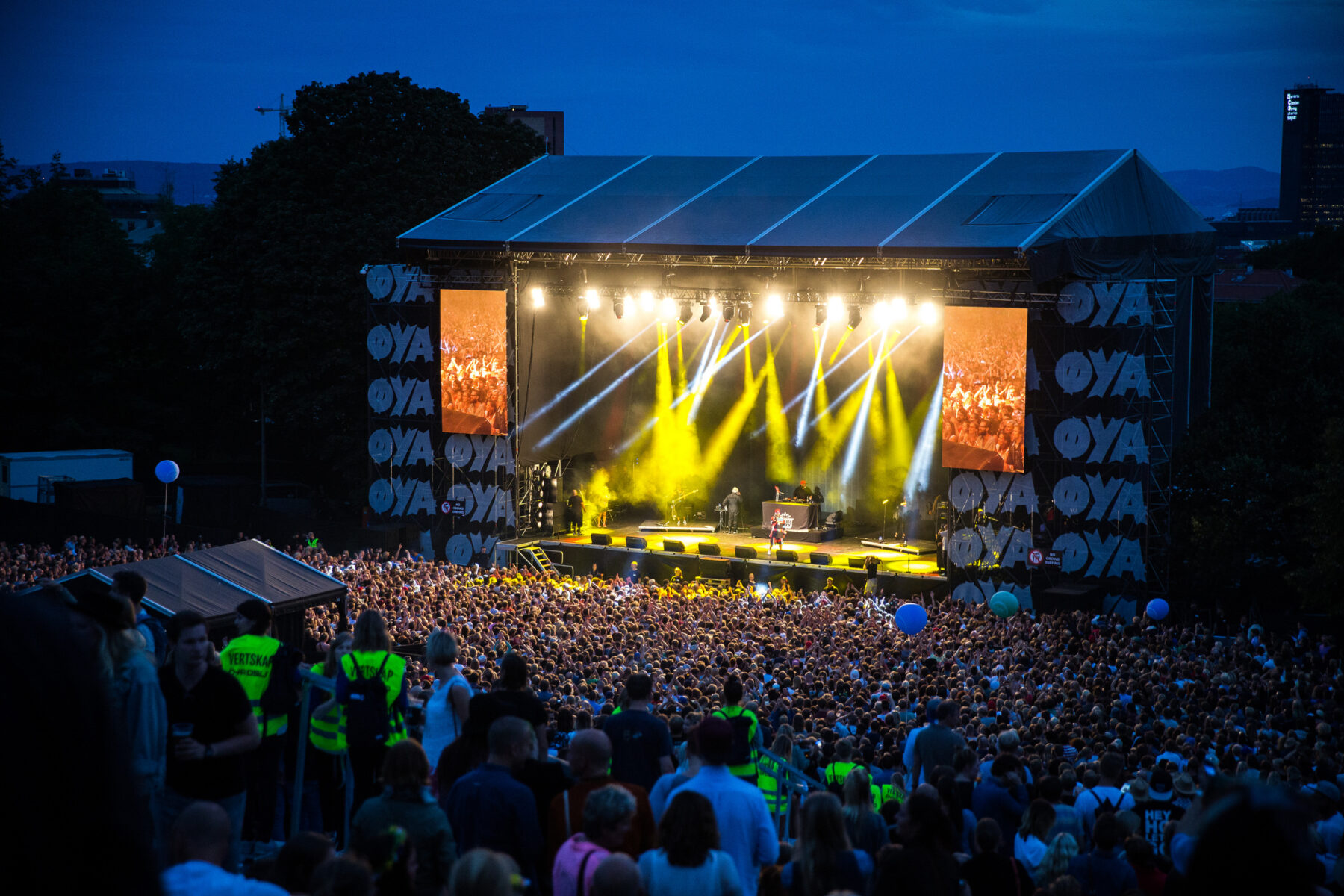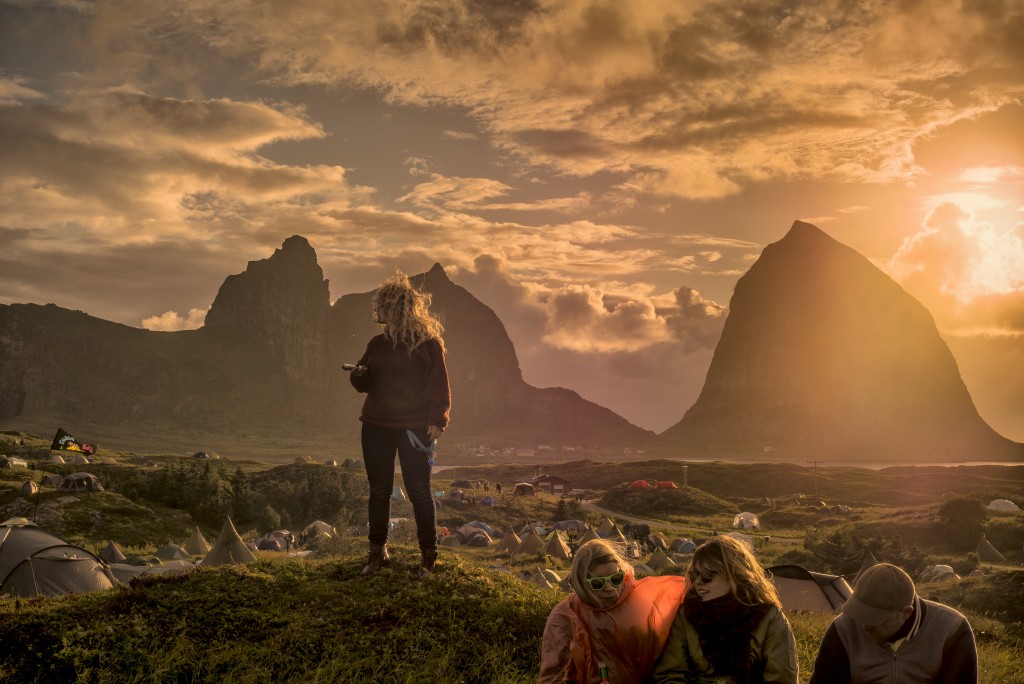In recent years, Norway has made its name as a country with a complex and varied musical output. Though a nation of only five million, Norway’s music scene is one of the most vibrant and varied in Europe – with long and storied traditions in jazz, pop, folk and metal of all kinds.
The nation’s musical reputation is reflected in its array of festivals, with events of all kinds across the country, often in extraordinary locations – whether beside a fjord, atop a mountain, upon an island or in a cave. With summer finally here, the festival season has begun – we look at some of the best and most interesting festivals coming up on the calendar…
As far as city-based festivals go, Oslo’s Øya has a claim to being the biggest in Norway, if not Europe. First run in 1999, it takes its name from Kalvøya, an island just outside of Sandvika, where the first two events were held. Since the move into the capital, it has grown into one of the most prominent festivals in the land, characterised by a strong community spirit and attracting acts such as Sigur Ros, Fleet Foxes, Arctic Monkeys, LCD Soundsystem, Pulp, Blur, Kraftwerk, The National, The Knife, Outkast, Neutral Milk Hotel and Beck over the last decades.
Much like Oslo, Øya has continued to grow. After several years in the medieval park, in 2014 it moved uptown to a larger site in Tøyenparken, close to the Munch Museum and Botanical Gardens. The new location is larger and more suited to live music, with all three outdoor stages having amphitheatre-style banking in front of them. Booker Claes Olsen says the new location has been a success: “Norwegians very often say ‘everything was better before’, so we had a lot of focus on making the new site as good as possible. The site is nearly twice as big, but we only increased the capacity by 1,000, so gave people more space.”
In many ways, this move reflects the changes taking place in Oslo as a whole. The relocation was necessary partly due to the regeneration of the formerly industrial dockside district known as Bjørvika. Adding to the 2008 opening of the striking marble-and-white-granite Opera House – famous for its elongated sloping roof – numerous other high-rise buildings were erected in the same area in 2010. Rather unaffectionately named ‘The Barcode Project’ due to their blocky black-and-white profile, these buildings have, for better or worse, changed the skyline of Oslo forever. (In an ironic twist, Øya’s neighbour, the Munch Museum is due to relocate to Bjørvika in the next few years.)
Øya’s prestigious position in the Norwegian music calendar and its commitment to booking the best and most exciting home-grown music makes it an excellent showcase of local talent to international guests. This is evident again in 2016, as PJ Harvey, Massive Attack & Young Fathers, Ane Brun, Highasakite, Aurora, New Order, Kvelertak and Jamie XX are all due to play. An additional electronica-based tent will be placed on the festival grounds, acting as a hub for the electronica that Norway has become renowned for.
Beyond its stellar line-ups, Øya is also known for its environmental responsibility. Sustainability has been a goal right from the start, but there is always more that can be done. Claes Olsen explains: “With each year we have made improvements – from using all-clean energy to reusing building materials, from recycling 70 per cent of the waste at the festival to serving all organic farm-bought food.” In 2014 Øya won an ‘Outstanding’ commendation from the Greener Festival Awards for the seventh year in a row, as well as organic food certifier Debio’s award for ‘Best Event’. But the environmental philosophy is not limited to the event itself, Olsen explains; it is also about encouraging others to do the same on a personal level: “If we can get some of the 70,000 people visiting Øya to eat vegetarian once a week or use their bike instead of driving to work, we’ve made a real difference”.
As well as cutting diesel generators and recycling all waste, food is another consideration. In the past, festival food has not generally been the most appetising or the healthiest. But, as Olsen puts it, “You won’t sell the world’s most sustainable burger if it is not tasty as well.” At Øya, the gastronomy is as well curated as the music, with some of Oslo’s best restaurants and eateries represented on site. In 2013, Øya formed a partnership with Mathallen, a new food court by the city’s Grünerløkka district and a hub for independent food and drink businesses. “We want our audience to look forward to their festival meals as much as they look forward to our concerts,” says Olsen.
Øya, Tøyenparken, Oslo. 9–13 August 2016. http://oyafestivalen.com/

Photo: Slottsfjell/ Christian Roth Christensen
Although Øya can claim to be the country’s ‘capital’ festival, there are numerous others that do their local population proud. For three days in mid-July, the historic town of Tønsberg comes alive with tens of thousands of festivalgoers and reams of eclectic acts for Slottsfjell. The hilltop location has an imposing stone tower at the summit and panoramic views of the surrounding area. The slow sunsets visible from here bathe the whole site in a golden-red glow. Almost as impressive is the cavernous town warehouse, Kastellnatt, used for the after-hours clubs. This year’s line-up includes Susanne Sundfør, Bring Me The Horizon, Dillion Francis, Grimes, Bendik, Wiz Khalifa, Lissie, as well as Todd Terje & The Olsens. Ingebjørg Bratland will be performing the traditional midnight concert.
Slottsfjell, Tønsberg, 13–16 July 2016. http://www.slottsfjell.no/
Pstereo, which runs for two days in mid-August every year, is another city-park festival. The area it occupies in Trondheim’s riverside Marinen is compact and convenient but nevertheless attractive, with the ancient Nidaros Cathedral looming in the background. As a nod to regional pride, its name comes from local rock band DumDum Boys’ 1990 album (the title track of which is also known as an Emilie Nicolas cover in her 2013 debut single). Notable acts playing across the 2016 weekend include Sigur Rós, The Thurston Moore Band, Kakkmaddafakka, Ary, The Luminers and Dagny.
Marinen, Trondheim, 18–20 August 2016. http://www.pstereo.no/
A lot of Norwegian music has a reputation for defying categorisation. Some might call it ‘avant-garde’ or ‘contemporary’; others might reject labelling it at all. For a window into Norway’s wayward musical soul, Ultima – Oslo Contemporary Music Festival is a good place to start. Established in 1991 and designated an official ‘cultural hub’ in 2006, the festival claims Crown Prince Haakon as a patron and makes use of some of the most interesting spaces for live music in the city. This year, these include the Kulturkirken Jakob and Sentralen, a brand new culture centre located in an old bank building. Highlights for 2016 include the opening concert with Rolf Wallin, Heine Avdal and Yukiko Shinozaki.
Various locations in Oslo, 8–17 September 2016. http://ultima.no/en/
Although Øya and other city festivals benefit from strong line-ups and accessibility, there are others that offer something more compelling. The physical geography of Norway affords opportunities for experiences impossible to recreate elsewhere. Some landscapes are so picturesque that they almost defy description. Give them a soundtrack and add in the atmospheric qualities of a festival and the rarity of the event is enhanced even more.
In Northern Norway, one such festival occurs on an archipelago of more than a thousand islands, practically priding itself on its inaccessibility and remoteness – or at least on the fact that people still travel in their thousands to attend in spite of it.
Trænafestivalen (aka Træna – the name of the group of islands where it takes place) was founded just over a decade ago by the pioneering Erlend Mogård-Larsen, general manager for Oslo’s by:Larm and co-founder of the wide-ranging and ambitious yearlong SALT festival. Although the line-up is carefully curated, few other festivals come close to matching Træna for scenery. In festival season, daylight lasts for 23 hours. Add a lengthy journey – a four-or-so hour boat ride from Bodø (itself fairly remote) – and you have something incomparable.
The majority of the festival takes place on Husøya, though guests are occasionally ferried away for concerts on other islands. The most impressive is Kirkhelleren on the island of Sanna. Known also as ‘Mother Nature’s Cathedral’, it is a 30-metre rocky cave with steep sides and fantastic natural acoustics. So many times venues are described as ‘special’, but once you’ve played in this grand and imposing cave, anywhere else must seem ordinary. Other venues include the 200-year-old, white wooden church on Husøya, and the minuscule Petter Dass chapel, named after the area’s famous 17th-century poet. As with much of this region, Træna’s traditional industry is fishing and the food on offer is, unsurprisingly, mainly from the ocean. The tented Fishy Fishy Nam Nam restaurant, which pops up every year and serves dishes straight from the sea, has become a Træna institution, according to festival manager Anita Overelv.
Linn Nystadnes played the festival in 2011, as part of Oslo band Deathcrush, and believes the appeal extends beyond the scenery: “Norway has a music festival in every fjord, but the location of Træna combined with real enthusiasm for music – and not just the beer tent – places it on most musicians’ wish list.” Even the journey had memorable moments, she says: “Our band host knew the people who run the local skate shop in Bodø, so we left all our gear there to go have whale carpaccio and take in the view. There is basically ‘a view’ wherever you go up north …and seafood. But you can’t help being overwhelmed, again and again.”
Why do people keep going back to this far-flung archipelago? Overelv has a few ideas: “I think it is the nature, the exotic destination and an alternative experience. And the fact that everybody has to get here by boat. It creates a feeling of an ‘all-together family’ – stuck on an island. And the music is great, even if you haven’t heard of the bands.”
Nystadnes agrees: “The surreal situation of being so far away from the rest of the world makes everyone, visitor or local, act like ‘what happens in Træna, stays in Træna’. It’s crazy how far away from the mainland the islands really are. Being in the middle of the ocean like that, nothing but sea to be seen, it makes you feel like the rest of the world could disappear – and you wouldn’t even know. That’s what sets Træna apart from all these other festivals in amazing locations. It might be a long and expensive trip, but if you’ve been there once, you know you’re coming back.”
Trænafestivalen, Træna. 7–10 July 2016. http://www.trena.net/en/
In other extremes, the award for the highest festival should probably go to Vinjerock, named after 19th-century poet Aasmund Olavsson Vinje. It takes place in Eidsbugarden, on the edge of the Jotunheimen national park, some 1060m above sea level. Although music is the basis for the festival (Aurora, Farao, Frøkedal & Familien, Lars vaular, Miss Tati and Razika are playing this year), the numerous activities that happen in tandem, including orienteering and fishing, take full advantage of the surrounding area. The festival’s website claims that Vinje was Norway’s first hippie – given that he’s known for the phrase: ‘It is so important to enjoy yourself’, who could argue otherwise?
Vinjerock, Eidsbugarden i Jotunheimen, 21–24 July 2016. http://www.vinjerock.no/
One of the most defining features of Norwegian music festivals is the emphasis on community. Volunteers are a vital part of their running, but there is often more than a degree of local pride involved, too. Riddu Riđđu was founded in the early 1990s to celebrate the culture of the indigenous people of Northern Norway: the Sámi. It was established when a group of young Sámi attempted to overcome their feeling of detachment and underrepresentation through an event that recognised their culture and background. Prominent Sami musicians include Mari Boine, who plays this year, and Adjágas. As well as celebrating Sámi culture, it also aims to promote cultures of other indigenous and Northern peoples and its programme includes music, literature, art, seminars and more. Riddu Riđđu takes place in Manndalen/Olmmáivággi, not far from Trømso, with a children’s festival running alongside.
Riddu Riđđu, Manndalen/Olmmáivággi, Kåfjord, 13–17 July 2016. http://riddu.no/en
Whether in a field or by a fjord, Norway’s astonishing variety of festivals shows that there is something, somewhere for people of any age, in any location and interested in any style of music. It’s just narrowing down which one to attend that’s the difficult part.


